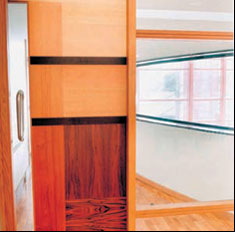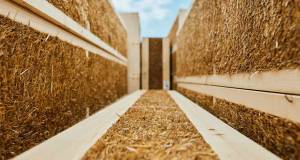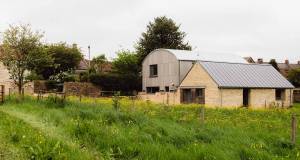- Timber
- Posted
Woodspec - First timber specifiers guide produced in Ireland
Woodspec: A Guide to Designing, Detailing and Specifying Timber in Ireland is a comprehensive specifiers’ manual which reflects an increasing confidence in wood usage and design in Ireland. The guide and accompanying CD-ROM provide wide-ranging information to ensure the efficient production of precise specifications in relation to the appropriate use of timber. It was published by the Wood Marketing Federation because information and guidance on timber for specifiers was not available to anything like the same extent as other materials such as concrete, steel and plastic. Although Woodspec is designed with the specialist in mind, its clear and accessible format has attracted a wide audience. It is mainly aimed however at architects, engineers, designers and other specifiers. The Wood Marketing Federation is also conscious of its educational value and has been promoting it to relevant third level students.
The 300 page guide provides a challenge to specifiers to use wood creatively. It is the first guide of its kind in Ireland to include designing, detailing and specifying timber. COFORD (the National Council for Forest Research and Education) produced and maintains the Woodspec website (www.coford.ie/woodspec) and also offer a complimentary free advice service on timber specification. The guide has been well received both in Ireland and overseas and its availability, especially on the web, ensures that it has wide readership and usage. Woodspec is the result of four years of work by an editorial, design and management team comprising architects, engineers, wood scientists, foresters, designers, builders and a range of specialists including processors and wood treatment experts. The guide illustrates the versatility of wood and will provide the user with the necessary information for architectural and engineering expression.
The editorial team behind Woodspec took nothing for granted from their audience when preparing the guide. They set the tone for the entire guide by including a section at the beginning entitled “Ten Timber Principles”. These might be obvious to some specifiers who are familiar with wood usage and design but in Ireland we do not as yet have a wood culture and Ciaran O’Connor, technical advisor to the Woodspec project team and Senior Architect with the OPW, believes that these principles are worth restating. They cover the essence of good practice in the use of timber.
The principles are:
Respect the climate
Specify the correct moisture content
Ensure durability through preservation
Ensure fitness for purpose
Eliminate wet and dry rot
Use graded timber
Have no fear of fire
Get your walls breathing
Conserve historic timber work
Be ecologically aware
The guide is clearly laid out with an introductory section which includes a chapter on how use the guide, the aforementioned ten principles and a chapter entitled “From Saw to Site”. This includes essential wood characteristics, strength grading, preservation and timber finishes. In addition it deals with aspects of timber treatment from mill to building site and includes handling of timber in off-site and on-site construction. This is followed by the following five sections:
A: Design Guidance
B: Detailed Drawings
C: Sample Timber Specifications
D: Timber Building Specifications
E: Reference Materials
Design Guidance (A) and Detailed Drawings (B) describe and illustrate good practice and appropriate use of timber and timber products. For example Detail B 6.10 includes a range of drawings for Timber Frame - First Floor Construction such as Detail 6.10.4 for load bearing partitions. Like all drawings, it includes detailed accompanying notes.
The section on Sample Timber Specification (C) gives a complete set of specifications for timber suitable for the preparation of a Bill of Quantities requiring little or no modifications. Building Specifications (D) allows the specifier to provide the contractor with specifications relating to structural and building applications in wood while the final section on Reference Materials (E) includes an illustrated list of Irish and imported timbers and their properties, a glossary and an index. In all, 21 woods (8 softwoods and 13 hardwoods) are illustrated. A summary table of these woods is also provided showing individual characteristics and properties including texture, wood density, moisture movement, durability, working properties and availability. All sections are clearly illustrated with close to 300 detailed drawings and tables.
Although Woodspec is designed to facilitate the preparation of specifications, users and readers may dip into it at any section where information is needed. Also, the five sections of the guide are interlinked which maximises its accessibility. For example, cross-referencing is facilitated by the use of a bar at the bottom of each page which leads the user on to related information such as detailed drawings and design guidance.
Woodspec illustrates that timber has advantages over other building and design media but it requires knowledge and expertise to maximise its added value and its use. It also requires creativity because as O’Connor points out, wood culture, like any vibrant culture must spread new roots, sprout new ideas and have contemporary relevance, if it is not to stagnate. He believes that we in Ireland have an ecologically friendly and renewable resource awaiting development and the guide is to facilitate the user’s contribution to that wood culture.
O’Connor is fully aware of the work to be done to achieve a wood culture in Ireland. He says: “We have inherited a fragmented European timber heritage because of our history and the depletion of our woods in the 17th century. Today, we in Ireland are quickly moving towards a surplus of timber. We need to develop a wood culture comparable to and complementary with, our masonry culture. Specifiers in many European countries who have a tradition of wood usage and design have a full appreciation of the nature of wood and how to handle it. These are at ease with wood as a wide ranging versatile design and building material ranging from aesthetic use to functional and highly demanding structural situations”.

O’Connor maintains that because timber is not a man made product, manufactured under rigid control, some are suspicious that it is not amenable to good specification and control. Proper application of Woodspec should help reduce these fears and give specifiers the knowledge and confidence to use wood in a wide range of applications. This would bring Ireland into line with other European countries with strong wood cultures. The Guide ensures that Irish specifiers will be well equipped to meet the challenges and opportunities that innovative use of wood provides.
Woodspec has been promoted by the Wood Marketing Federation through a series of roadshows in Waterford, Wexford and Dublin this year and it is proposed to follow these up with roadshows in a number of venues - north and south - in November. In addition, the guide will be promoted to third level colleges with a view to incorporate Woodspec as a module in engineering and architectural courses. The Wood Marketing Federation also has plans to launch a wood promotion programme in 2004 and at a recent meeting between a broad range of organisations in the Irish wood chain there was strong support for this initiative. The main aim of the Wood Marketing Federation is to promote the use of wood as a versatile, viable and renewable resource.
The production of Woodspec coincides with a period of new confidence in the Irish forest industry which now has a total annual turnover of €510m. It also coincides with greater public awareness on the value of green energy and products. The Wood Marketing Federation acknowledges this and believes that it is time for a generic promotion of wood. Woodspec will be at the core of this campaign which will promote wood as a sustainable resource awaiting creative architectural and engineering development.
Donal Magner is Secretary of the Wood Marketing Federation and project manager of Woodspec. He is a forestry consultant specialising in communications and publishing. He formed Magner Communications in 1993 after a career in forest management and communications with the Forest Service and Coillte. He holds a Masters Degree in forestry from University College Dublin. He is editor of the Forestry Yearbook and writes regularly on forestry and wood industry issues for a number of Irish and international publications.
Related items
-
 History repeating
History repeating -
 King of the castle
King of the castle -
 Energy poverty and electric heating
Energy poverty and electric heating -
 Build Homes Better updates Isoquick certification to tackle brick support challenge
Build Homes Better updates Isoquick certification to tackle brick support challenge -
 Flat earth
Flat earth -
 Material matters - A palette for a vulnerable planet
Material matters - A palette for a vulnerable planet -
 Derelict to dream home
Derelict to dream home -
 Final opportunity for construction professionals to secure 80 per cent training subsidies
Final opportunity for construction professionals to secure 80 per cent training subsidies -
 Big picture - Points of access to resilient living
Big picture - Points of access to resilient living -
 Storm breaker
Storm breaker -
 Enniscorthy to host ‘make or break’ sustainable building summit
Enniscorthy to host ‘make or break’ sustainable building summit -
 Ecocem executive John Reddy becomes the first Irish President of the Institute of Concrete Technology
Ecocem executive John Reddy becomes the first Irish President of the Institute of Concrete Technology

